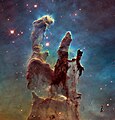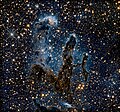ფაილი:Eagle Nebula - GPN-2000-000987.jpg

ზომა წინასწარი გადახედვისას: 606 × 600 პიქსელი. სხვა გაფართოება: 242 × 240 პიქსელი | 485 × 480 პიქსელი | 776 × 768 პიქსელი | 1 035 × 1 024 პიქსელი | 1 944 × 1 924 პიქსელი.
თავდაპირველი ფაილი ((1 944 × 1 924 პიქსელი, ფაილის ზომა: 1,18 მბ, MIME ტიპი: image/jpeg))
ფაილის ისტორია
დააწკაპუნეთ თარიღზე/დროზე ფაილის დასათვალიერებლად, როგორც ის მაშინ გამოიყურებოდა.
| თარიღი/დრო | მინიატიურა | ზომები | მომხმარებელი | შენიშვნა | |
|---|---|---|---|---|---|
| მიმდინარე | 00:30, 3 ოქტომბერი 2012 |  | 1 944×1 924 (1,18 მბ) | Ras67 | losslessly cropped with Jpegcrop |
| 01:17, 9 აპრილი 2009 |  | 1 993×1 973 (1,45 მბ) | BotMultichillT | {{Information |Description={{en|1=These eerie, dark pillar-like structures are columns of cool interstellar hydrogen gas and dust that are also incubators for new stars. The pillars protrude from the interior wall of a dark molecular cloud like stalagmite |
ბმულები
ამ ფაილზე ბმული მოცემულია შემდეგ გვერდებზე:
ფაილის გლობალური გამოყენება
ეს ფაილი გამოიყენება შემდეგ ვიკებში:
- გამოყენება ar.wikipedia.org-ში
- გამოყენება en.wikipedia.org-ში
- გამოყენება eu.wikipedia.org-ში
- გამოყენება fa.wikipedia.org-ში
- გამოყენება hu.wikipedia.org-ში
- გამოყენება kw.wikipedia.org-ში
- გამოყენება zh.wikipedia.org-ში







